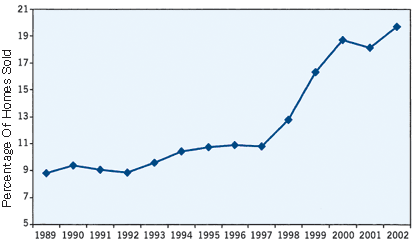
At the 2003 Fall Construction Forecast Conference held by the National Association of Home Builders (NAHB) at its headquarters in Washington, the final subject of the day was "Consolidation of Home Building Industry - Where is it Going?" On this topic, Gopal Ahluwalia, staff vice president - Research, Economics Group, NAHB, provided a presentation on builder consolidation trends.
Ahluwalia noted that a white paper produced by Anderson Corporate Finance LLC, published in June 2002, concluded that, by 2011, the top 20 builders in the United States could be generating "more than 75 percent of the home sales." Thus, the NAHB decided to do a study of builder consolidation.
Why is consolidation occurring? Ahluwalia pointed out several factors. One reason is to increase earnings growth. Another is to allow the company to expand into new markets. Another major reason is to allow the builder to diversify/expand its product offerings - such as homes for first-time buyers, upscale homes, etc. - or to diversify/expand its market segments - such as the custom home market, the condominium market, etc.
Builders are also consolidating to increase their market penetration/market share and to acquire additional management talent. Also, consolidation allows the builder to increase its land inventory and gain volume discounts through national buying. This last idea of volume discounts through national buying is where HVAC contractors involved in new construction could feel the squeeze from the potentially growing dominance of large national home builders.
The Big Get Bigger
Ahluwalia said that it is "mostly publicly traded building companies who are consolidating." Some large privately held builders are also getting involved. In addition, he said, some mergers are taking place "among medium-volume builders to make themselves attractive for acquisition by national builders." Those being acquired are mostly privately held builders producing a minimum of 200-plus housing units."The largest 10 builders are gaining market share," stated Ahluwalia. On the other hand, "the rest of the top 100 are staying level in market share."
Describing the rise in market share of the top 10 builders through last year, Ahluwalia pointed to a chart showing that there has been a substantial growth spurt for these builders from 1997 to 2002. (See Figure 1.)

Looking at average closings of the top 60 builders, he again said the numbers indicated significant growth for the top 10 builders from 1997 through 2002, while the other 50 builders have remained relatively flat.
In 2002, Ahluwalia commented, the No. 1 builder had approximately 32,000 starts. The No. 10 builder had 9,000 starts. The No. 20 builder had 4,000 starts. So there is already a considerable concentration at the top.
The estimated growth from acquisitions for the top 10 builders has been substantial in recent years. (See Figure 2.)
Ahluwalia set 1995 growth at 85.6 percent. In 1997, it was 79.6 percent. In 2001, it shot up to an astounding 404 percent. For 2002, it eased back to a still very aggressive 72.4 percent.

The Urge To Merge
"Mergers and acquisitions started in the early 90s and went into full swing during the mid-90s," he said. "Mergers and acquisitions are likely to increase in this decade."The big national builders "will continue to expand operations by acquiring local or regional builders."
He noted, "The national builders have started taking advantage of volume purchases." In addition, these builders "are streamlining the process of hiring and retaining subcontractors and specialty trade contractors." In other words, the national builders are looking to reduce the number of suppliers and contractors they work with. All of this is being done to help reduce the cost of construction.
Those HVAC contractors currently working with local or regional builders that could be acquisition targets may need to consider whether there will be any reevaluation and reduction of contractors used. Ahluwalia remarked that one large builder he recently talked to has reduced the number of subcontractors for electrical and plumbing work from 26 down to two. Similar sharp reductions could also be seen for HVAC contractors.
And even if your local or regional builder intends to remain independent, things could still get difficult.
"According to the high-volume builders," stated Ahluwalia, "small and medium-volume builders will be squeezed because of construction cost differential and lack of land available to them." So the new construction HVAC contractor affiliated with a local/regional builder could feel the pinch as well.
Large national builders may prefer to work more with large contractors. And the push for volume purchasing and cost reductions may make profit margins for HVAC contractors even slimmer.
Look for more coverage of the 2003 Fall Construction Forecast Conference in future issues of The News.
Publication date: 11/10/2003


Report Abusive Comment